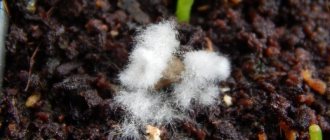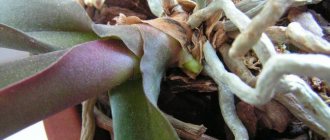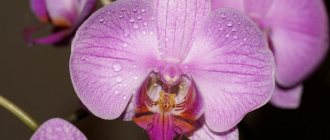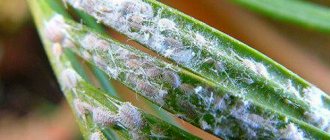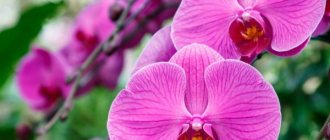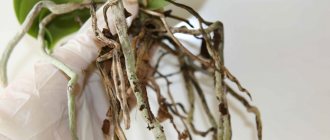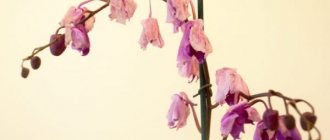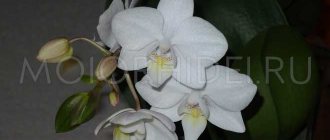In orchids, like in other plants, there are diseases caused by pathogenic microorganisms and those that do not have an infectious factor.
Often such diseases appear on the roots of the plant and are associated with non-compliance with the conditions of keeping the flower.
The fight against all manifestations of diseases, as well as proper care, will help maintain the health and regular flowering of the orchid.
Healthy orchid root system: what it looks like, color, elasticity.
Roots are an indicator of the health of an orchid. Normally, they are dense, elastic, white or yellowish in color, and after watering they acquire a light green color. The color of the roots is determined by the type of orchid and often depends on the fertilizing applied.
Some species have naturally dark roots and this is not a manifestation of the disease. Inside the substrate, where sunlight does not penetrate, the roots may turn a light brown color.
What to do to prevent the plant from getting sick again?
- To prevent infection by parasites, newly acquired or returned flowers from the dacha are subject to a two-week quarantine. At this time, the plants should be kept in a room separate from the main flower garden under close attention.
- To prevent infection, it is necessary to select the correct watering regime so that the substrate has time to dry between operations, and carry out regular spraying, increasing air humidity.
- When replanting an orchid, it is better to use a high-quality substrate from a well-known manufacturer, and when using bark, it must be subjected to heat treatment.
To prevent bugs from appearing on orchids, it is necessary to systematically carry out a preventive inspection of them. Such an event will allow you to detect the problem in time, apply the most gentle methods of controlling parasites and prevent the entire flower garden from becoming infected.
White orchid roots: why did they turn white?
Very often, a seemingly healthy plant will have white spots, plaque or balls on the roots. What are they and how to deal with them ? The answers to these questions will help maintain the health and beautiful appearance of the orchid.
The appearance of white spots and spots
The appearance of such dots and spots on the roots may be non-infectious in nature , associated with watering the orchid with hard, unfiltered water. Wherein:
- a significant amount of salts accumulate in the soil, as a result of which the composition of the soil changes;
salinity of the substrate prevents the normal flow of air into the root cells.
Excess salts can also appear as white spots on the surface and in the depths of the substrate.
Why does white mold and plaque appear?
This coating on the roots forms mold (looks like fluff), which is formed as a result of the rapid proliferation of microscopic fungi from the genera Alternaria, Cladosporium, etc.:
- Fungal spores can remain dormant for a long time and not manifest themselves in any way ;
- When favorable conditions arise, they begin to actively multiply , penetrate into the voids between the bark, and spread over the surface of the substrate, roots and stem of the orchid.
An ideal environment for the proliferation of mold fungi occurs when occur simultaneously :
- excess substrate moisture;
- high environmental humidity;
- fairly low temperatures (usually no higher than +20℃).
Compliance with care rules is the best prevention of infectious root diseases.
White balls
small white balls form on the roots of the orchid - a protective adaptation of soil fungi to unfavorable conditions.
They are formed as a result of the interweaving of thread-like formations of the mycelium - hyphae and can have a spherical or irregular shape, and also reach a size from several millimeters to 2 or more centimeters.
As soon as favorable conditions arise for the fungus, the white balls:
- germinate in the form of a web - mycelium, capturing more and more new areas of roots and substrate;
- The mycelium takes from the soil a significant part of the nutrients needed by the plant.
If the fungus is not dealt with, then in the later stages of its development, the orchid roots begin to die .
What does white plaque look like on an orchid?
A white sticky coating can affect a flower in two cases: the plant has contracted an infection or it has been attacked by pests. Both the first and second are extremely dangerous for the orchid: they can quickly kill it. Treating such ailments is also quite difficult.
For your information! If the orchid has been attacked by parasites, then you should notice a white coating formed on the leaves (less often the stems), similar to cotton fibers or flakes. This means that the plant has been sick for quite some time, since the first signs of pest damage are the formation of sticky drops on the surface of the leaves.
If the plant becomes infected, the symptoms are somewhat different. Usually, when fungal infections occur, the lower surfaces of the leaf blades are the first to suffer. They become covered with a powdery coating, which grows as fungal spores develop. The danger is that the fungus grows very quickly, which means that the lack of timely treatment will lead to rotting of the orchid.
White plaque may appear in the following areas of the plant:
- on sheet plates;
- stems;
- root system.
On the leaves
Often, diseases and infections affect orchid leaves. Over time (and without proper treatment), the problem can spread to the stems, but rarely do problems start there.
Usually those flowers that do not receive proper care are at risk. Their immune system weakens and opens the way to all possible infections, among which white plaque is the most common. Lack of proper care leads to a failure of the orchid's metabolic processes, and this in turn affects the composition of the plant juice. It is because of this that various diseases and pests perceive orchids as easy prey.
Depending on the causes of the lesion, the disease may look different. Most often, the main signs of problems are:
- drying of orchid leaves and stems;
- premature completion of flowering (poor flowering);
- the inflorescences quickly fade and fall without even opening;
- Sticky drops appear on the leaves;
- Over time, the sticky drops turn into a white coating.
Important! If the plant has been affected by pests, then plaque appears on the front side of the leaf plates in the form of flakes or cotton fibers. If a plant is affected by a fungal infection, the disease will appear on the underside of the leaves and will look like a powdery coating that quickly grows over the surface of the leaf and stem.
On the stems
White bloom rarely appears on orchid stems. Most often, it moves there in the later stages of disease development from the leaf blades. It usually looks like this:
- sticky drops of sweet secretion;
- white powdery coating with the texture of cotton fibers;
- gray-green mold.
On the roots
Orchid roots in most cases are subject to infectious attack. This part of the plant is difficult for pests to access, so they prefer something simpler, such as leaves.
The main problem that orchid owners may encounter is mold. This fungal infection looks like a fibrous coating that can appear on all parts of the plant (except inflorescences). Mold reproduces with the help of spores, so the disease spreads quickly, affecting all healthy areas in a short time. If a fungus was brought into the house, expect complete infection of the plants.
The color of mold can vary:
- light gray (this variety is called white);
- green;
- black.
Outwardly, it looks like a shaggy crust that covers the roots of the plant. This disease is also dangerous because it can hibernate for a long time somewhere in the roots of the orchid. As soon as the external environment allows, the fungus immediately wakes up and begins its active activity.
Important! Mold can infect all parts of the plant as it spreads through the voids between the bark of roots and stems and along the surface of the soil.
Causes of white plant roots
The reasons that cause the appearance of white areas on the roots of an orchid can be of different nature.
Poor soil quality
The quality of the soil directly affects the condition of the orchid’s root system:
- a dense or poor-quality substrate disrupts air circulation and, as a result, the supply of oxygen to the roots, creating conditions for the development of pathogenic microorganisms;
- every two to three years the plant needs to be replanted into a new substrate, since the old one decomposes, loses its properties, and becomes an excellent environment for the development of fungal diseases.
Lack of moisture
Irregular or poor watering can cause the roots to dry out, causing them to wrinkle and turn white. First of all, these processes will manifest themselves on aerial roots, which can also be facilitated by low humidity in the room.
Prevention of this is the correct watering regime and regular spraying of the orchid.
Lighting
Lack of light is one of the main causes of all plant diseases.
An orchid needs a lot of diffused light , so in the autumn-winter period it is better to illuminate the plant with a phytolamp.
Inappropriate pot size
Very often, diseases of the root system are associated with incorrectly selected pot volume . A pot that is too large increases the likelihood of water stagnation and makes it difficult to assess the degree of drying of the substrate.
Infections
Orchid roots can be affected not only by mold fungi, but also by bacterial rot, which does not form a white coating or spots on the surface of the roots.
Hard water for irrigation
hard (highly mineralized) water for irrigation You can also soften water at home using:
- special water filters;
- by adding 3 g of wood ash or 100 g of fresh peat to the water, which are stirred in 10 liters of water.
To prevent it from forming, the plant must be watered exclusively with soft water (melt, rain or settled water).
Why might it appear?
There are many reasons for the appearance of a harmful white coating on an orchid. Most often the plant gets sick:
- with improper care;
- non-compliance with temperature conditions;
- improper watering.
It is also worth noting that the development of the disease may be a consequence of contamination of the substrate. So thorough disinfection of all tools and soil is a necessary condition for normal plant growth.
Improper care
These include many factors. Most often, the plant suffers in winter, since at this time the amount of natural light decreases, the air becomes drier, and water stagnates in the soil.
Common consequences of improper care are rotting of the root system and the formation of fungal plaque on the roots, leaves or stems. All this happens due to waterlogging of the soil.
As a result, the orchid:
- dies;
- attracts pests;
- rots, infecting the substrate.
Important! When watering, focus on the consistency of the soil in the pot, and not on the time interval between waterings. If the soil is dry enough, you can add a new portion of water.
Careful adherence to the watering regime must also be accompanied by strict adherence to the temperature regime, since mealybugs, which are dangerous for orchids, feel quite comfortable in a dry and warm place, but are afraid of moisture. To keep the roots healthy, but at the same time protect the leaves and stems from pests, wipe the leaf blades with a damp cloth and use spraying instead of watering.
The temperature in summer should remain within +18...+30 degrees, in winter +20...+23 degrees is sufficient. Air humidity should be at least 55%.
Timely removal of dried parts of the plant is also important. This helps protect the orchid from the spread of pests. Standard pruning is excellent prevention.
Infection in the soil
Sometimes the cause of orchid disease can be contaminated soil. That is why most flower growers advise purchasing ready-made soil mixtures only in trusted stores.
If you prefer to prepare the substrate yourself, be sure to disinfect:
- Take pre-prepared bark for the substrate.
- Dry the bark in the oven at +60 degrees for 15–20 minutes so that all possible pests and bacteria die.
- Disinfect the plant seedlings before planting them in sterile soil.
After replanting the plant, throw away the soil from under it, especially if the plant is sick with something. Do not replant other flowers in such soil under any circumstances, as there is a high risk of their infection and death.
Powdery mildew
This disease most often affects the leaf blades of orchids. Primary signs of the disease appear only in small areas. This is why most flower owners do not notice them. Over time, the affected area increases significantly.
The carrier of powdery mildew is powdery mycelium, which is capable of multiplying to incredible sizes in a short time under favorable environmental conditions. Outwardly, it looks like the surface of a sheet sprinkled with flour.
Causes of powdery mildew infection:
- sudden changes in temperature;
- waterlogging of the soil;
- lack of timely therapeutic or preventive measures.
Lack of treatment for such an infection leads to the death of the plant.
Mealybug
Mealybugs, otherwise called hairy lice or felt lice, belong to the family of hemipteran insects, which have nothing in common with the worms we are used to. Many inexperienced gardeners confuse scale insects with scale insects, although these insects are not even similar in appearance.
The mealybug has an oblong body 2–6 mm in length, beige or white in color. Their body is completely covered with a waxy coating, reminiscent of ordinary flour. They have bristles on the sides and two pairs of long hairs on the back.
There are many varieties of these pests in nature. Only three species pose a danger to orchids:
- Bristly. Their females have a red body tint, dusted with waxy “flour”. Males resemble flies in appearance and are capable of flight.
- Citrus. The body of females has a pinkish color and a light coating. They are the ones who leave sticky drops (sticky sweet secretion) on the surface of orchids. Males are brown in color and can fly.
- Seaside. The body of females is colored in gray-pink shades. Males have wings that allow them to fly from place to place.
Important! This type of pest can also reach the roots of the orchid. In addition, they secrete a special secretion that stimulates the formation of fungal infections and develops bacterial resistance to chemicals.
What to do if the roots of a plant turn white?
In all cases, when white spots appear on the roots of the orchid, the flower is transplanted into a new substrate and a new pot:
- after being removed from the soil, the roots are washed with warm water at a temperature of about 35℃;
- all unhealthy roots (dry, rotten or with white spots) are removed;
- in case of infection by fungi, the root system is soaked in a fungicide solution for 15 minutes.
Before planting the orchid in a new substrate, the soil should be soaked in boiling water for a quarter of an hour, and after drying, transferred to a container where the flower is subsequently planted.
water with a low mineral content is used for irrigation .
Orchids are very resilient plants and can recover even if they lose all their leaves or roots. Resuscitation measures, as well as care and proper care, will revive the flower and ensure long and lush flowering.
Why can they grow in the soil, on roots and leaves?
Pests in a flower garden do not appear on their own - infection with parasites occurs for several reasons. These experienced flower growers include:
- systematic overflow;
- low quality substrate;
- infection from other indoor plants;
- purchasing a plant with parasites.
Source of infection
If the plant has not recently been replanted, and new flowers have not appeared in the house, then the cause of the appearance of bugs is faults in care.
Stagnation of water leads to rotting of the bark, which easily infests parasites . In the bark of pine, which gardeners like to use as soil for orchids, various bugs live in natural conditions.
Such a neighborhood is imperceptible for a tree, but for phalaenopsis or dendrobium it can be disastrous. It is better to use a special filler, which includes not only bark, but also:
- charcoal;
- moss;
- coconut fiber.
The finished substrate has good moisture capacity and the necessary breathability.
Many gardeners like to plant indoor flowers in the open front garden in the spring. Together with nutrients, Kalanchoe or geranium are quite capable of “catching” scale insects or aphids. In the fall, this living creature will end up in the indoor flower garden. In a similar way, you can bring bugs with a purchased copy.
How to save an orchid from mold on the roots, leaves and other parts of the plant?
There are many types of flowers. However, one of the most beautiful is, of course, the orchid. The orchid itself is an unpretentious flower and adapts to different conditions.
If stored and cared for improperly, this beautiful flower can develop such an unpleasant thing as mold.
Why white and black mold appears in the pot, on the leaves and roots and how to treat the plant - let’s figure it out together. You will also see what this disease looks like on the plant.
Whitish coating on orchid roots from poor quality water
Many of us are familiar with the problem of the formation of white limescale on plumbing equipment due to high water hardness. The same crystallization occurs on the surface of the roots if they are watered with liquid from a water tap. When evaporating, the salts contained in the water turn into a solid chemical state and form a strong, impenetrable crust of white, gray or yellowish color. The shade depends on the composition of the water.
To prevent the damage that hard water can cause, it must be properly prepared for watering orchids.
How to get rid of it?
Let us consider in more detail what to do in this situation, how to combat the formation of this disease on various parts of the flower.
On the leaves
There are two types - white and black.
If white mold appears on the surface and in the axils of the leaves, this is the initial stage of the disease. You can fight it with a solution of copper sulfate. To do this, take a teaspoon of vitriol and dilute it in 2 liters of water. The solution should be a pale blue color . They should wipe the leaves, especially carefully in places where mold accumulates the most. Or spray 2 times a day until the plaque disappears.
If black mold has already appeared on the flower, then it is better to carefully trim the affected leaves and wipe the cut areas with the same vitriol solution.
On the roots
This type of fungus is more difficult to fight.
- First of all, it is necessary to completely dry the substrate in which the orchid grows.
- Then it is recommended to thoroughly loosen the soil, remove the flower itself from the pot and thoroughly rinse the damaged areas (recommended water temperature 35 degrees); if dried roots are found, it is better to carefully trim them.
- Place the treated flower (stems and roots) in the fungicide solution for 15 minutes.
In the substrate
Moldy soil is best disposed of . Before planting the orchid in a new substrate, you need to soak it (soil) in boiling water for about 15 minutes. After this, wait until it dries completely and only then fill the container where you place the orchid.
It is recommended to put 3 crushed tablets of activated carbon or wood bark into the substrate. After planting, it is not recommended to water the orchid for about 3-5 days. This is done to ensure that the damaged areas heal and new problem areas do not form. It is also advisable to place the orchid in a well-lit, dry place.
Below you can watch a video that tells you what to do with mold on an orchid:
If the entire plant is affected
If the flower is completely covered with mold, then you can try to carefully cut off the mold with a sharp knife , then treat the damaged areas with a solution of copper sulfate (how to prepare it is indicated above).
It is also recommended to transplant the flower into another pot with a new substrate, previously disinfected. After this, do not water the flower for 5 days and keep it in conditions with minimal air humidity, preferably in direct sunlight. Even in this case, you can use ultraviolet lamps and warm the orchid with them.
Why does a plant get moldy?
The most optimal conditions for mold to grow are warmth and humidity.
Most often, trouble occurs due to improper care. In this case, the plant weakens and its immunity decreases.
Very often, gardeners themselves provoke the appearance of mold on orchids:
- abundant watering and frequent heavy spraying if the flower is in a hot room;
- flower pots stand very closely, preventing the free movement of air between plants;
- the pathogens were brought from the store along with the substrate.
How not to treat a flower?
- Under no circumstances should high humidity be allowed in the room where the flower is located.
- Don't overdo the chemicals used to combat mold.
- Although drying and a sunny place for treating the flower are recommended, one should not forget that prolonged exposure to direct sunlight (especially in the hot summer period) can lead to thermal burn of a delicate orchid.
- If you use a solution of copper sulfate or fungicide, then you should not allow a high concentration of these chemicals, as this can cause a chemical burn to the flower.
How can you not fight?
You need to start fighting pests at the first sign of their appearance.
- Dry air contributes to the rapid proliferation of parasites, so some gardeners begin to regularly spray orchids in the hope of raising the humidity to the required level and getting rid of the bugs. This method is dangerous because insects get additional time to reproduce and develop.
- There is an opinion that ultraviolet radiation can destroy pests. This is one of the most common myths. In reality, you can get rid of insects using biological, chemical preparations or folk remedies.
Prevention
To do this, you need to make drainage holes in the pot where the flower grows. The substrate in which the orchid is located must be dried occasionally, that is, do not water it for several days. It is best to use clean filtered water for irrigation.
Occasionally add a weak solution of potassium permanganate to the water for irrigation (the color should be soft pink, not brighter). Sometimes you can add a couple of tablets of activated carbon or tree bark to the orchid substrate. Maintain temperature conditions. The optimal temperature is 22-25 degrees. Avoid high humidity and it is best to place the flower in a sunny place.
Prevention of plant damage
The most important preventative action is to choose a really healthy plant in the store. There cannot be any damage to the ground part of the flower, and the shoots and leaves should not be dry or deformed.
Next, you should test for the presence of parasites in the soil. You can do it like this:
- Pour room temperature water into a deep container.
- Place the pot with the plant in it so that the water level is a couple of centimeters below the edge.
- Wait 5-7 minutes.
After this, it’s worth keeping the flower separate from other indoor plants for a few more days and observing it.
Watch a video on how to test for pests on an orchid:
Reasons for appearance
The mold looks like moss or the well-known seaweed. It would seem what a danger such a formation could pose to your orchid. However, in fact, if you do not protect your indoor specimen from fungal invasion in time, the mold will grow and completely fill all the cracks in the substrate. Thus, the rhizome of the flower will be deprived of air, which simply will not be able to enter the contaminated soil.
Before deciding how to save your home flowering orchid from fungus, you need to determine why it appears in the first place. In this case, you will quickly eliminate the problem and find out what to do to ensure that this does not happen to your orchid again. Among the most common causes of mold on an orchid:
- humid microclimate and excessively moist soil. If these indicators are stable, it is not surprising that your houseplant is suffering from fungus;
- daylight. This factor also contributes to the development of microscopic mold spores.
Very often, domestic flower growers buy orchids in specialized stores. However, immediately take into account the fact that such specimens are sold in plastic containers that are not intended for long-term use. In most cases, they do not even have drainage holes through which excess water escapes. That is why the flower may suffer from excess humidity from the moment it appears in your home, which will lead to the formation of fungal components. In any case, be sure to find out what contributed to their development in your case in order to understand how to proceed further and how to revive the plant in a timely manner.

